It ... seems possible to imagine a complex which exists in the world as a thing in itself, generating the conditions of its own becoming, and which exists apart from the world as a model for it, exposing the conditions of its own artifice, a complex which undercuts its own logic by exposing the premise on which it was built, underpinning and undermining, drawing in and then distancing the spectator from the work in a theatre of theatre which is both true and false.
Alice Aycock, 1977

Alice Aycock. Waltzing Matilda, 2013. Reinforced fibreglass, approximately 15’ high x 14’6” wide x 17’6” long. Edition of 2. To be installed at 56th street in Spring 2014. Courtesy Alice Aycock / PAPC & Galerie Thomas Schulte, Berlin. Rendering.
Jill Spalding: Alice Aycock, you started out in the liberal arts. What brought you to sculpture?
Alice Aycock: I had always been drawn to the visual arts, but when I was growing up in the early 1950s, academic pursuits were foremost in school, so I was very academically oriented. The visual arts were not really promoted unless you were deemed likely to succeed, so I secretly made art in the basement of my house.
JS: Let’s go chronologically. You began work in the early 70s with big geometric spatial installations made out of concrete. Why concrete?
AA: When I began building the early works, artists were pioneering Lower Manhattan. We were moving into raw spaces and learning construction, building our own lofts with Sheetrock and 2x4s. I could put up a wall and make a bedroom and also go to the farmlands of Pennsylvania and build a structure. Young architects draw things at their desk; they rarely get to build. I got to draw at my desk and go out and test those drawings by scabbing something inherently temporary, but full-size, as a piece of art or non-functional architecture.
JS: Do any still exist?
AA: No, but gradually we are rebuilding them according to the original drawings. One was recently inaugurated in 2012 at Art Omi. It was permanently reconstructed underground and was a major undertaking. There is another one at Storm King Art Centre called Low Building with Dirt Roof (for Mary).
JS: Are they still vulnerable?
AA: Not at all. One of the great things about going back and rebuilding is that I’ve been able to fix some of the structural mistakes that I made as I was finding my way. All now have elaborate drainage systems, for example.
JS: You were also making elaborate pieces in wood. Some are on your website – Maze (1972), for instance. Have any of those survived?
AA: Maze lasted for about three to four years, then it disappeared. Most of the works that survived are in museums, but I have drawings and photographs of everything in my archives.
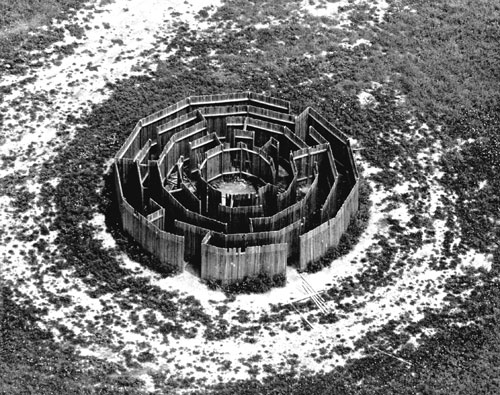
Alice Aycock. Maze, 192. 12-sided wooden structure of 5 concentric dodecagonal rings, broken by 19 points of entry and 17 barriers; 32 diameter x 6 ft h. Originally sited at Gibney Farm near New Kingston, Pennsylvania, (destroyed 1974)
Photo: Silver Spring Township Police Department, Mechanicsburg, PA.
JS: What was it about wood that worked for you then?
AA: When people speak of sculpture, they think of casting or carving, but I started out constructing. The tradition that I came from was Russian Constructivism with an architectural bias. When I began to build, I looked at readily available materials. Lumber was natural for me. I had easy access to a table saw and electric skill saws. It was something that I could do with a few assistants and on my own.
JS: You then moved to machinery – great steel assemblages with moving parts. What drew you to metal and the architecture of machines?
AA: Oil derricks, wheels and turbines and the insides of factories were fascinating to me because the way they looked was not just about aesthetics. Machines and factories had to function. The compositional system was different from: “I'm going to make this thing that looks good.” One of the reasons I like amusement park architecture – roller coasters and the sooperdooperLooper – is because they make machines accessible and provide the sense of weightlessness that one might experience in outer space. Also, the truss construction of curvilinear ramps is similar to labyrinthine paths. I had studied with Tony Smith, who was part architect, part sculptor and part painter, and I remember him talking about the New Jersey Turnpike under construction.
Travelling around, I was looking at oil refineries. They were cities in themselves. I was doing a lot of reading in my early years in anthropology, art and architectural history, French Structuralism, etc. I remember reading Levi Strauss, who was asking: “Why was it that humans knew how to make ceramics and domesticate plants and animals?” People seemed to have had a scientific, observational perspective very early on in history, but at the same time they operated according to religious and magical systems. I became very interested in the inter-digitation between magic and science, two different ways of operating that have persisted until now. I like to play with the opposing ideas of magic and science. Coming of age after the second world war with notions like the bad bomb and the peaceful atom, I realised that the technological innovations that come out of war can be quite extraordinary, but that the energy that we harness to feed and clothe ourselves can, at the same time, be very destructive. I culled images from the history of inventions, starting with the simple plough. Not that I’m religious, but doesn’t the Bible say: “Take your swords and beat them into ploughshares”? I wanted images that embody both the creative and the destructive to wrap around each other like strands of DNA.
JS: A great video that was shown at the Grey gallery showed you rambling on about the things and people that influenced you. You start with your father. He had a business called Aycock Inc, which made machinery and big industrial elements such as bridge girders. How did they impact on your work?
AA: My father was an architect-engineer. He had worked for the US Army Corps of Engineers in the second world war and helped to build the Burma Road, as I recall. The year I was born, he started a small company. As I grew, it did too. But even more marking for me, at the beginning, we lived in this little tract house. I would wait for my father to come home after work and he would dash through the door, run to his table and work on this tiny model. He would give me graph paper and I would try to draw what he was making. I remember very distinctly drawing by hand and he would say follow the lines, follow the graph paper, use a ruler. Gradually, I learned how to draw houses to scale. I was a little girl, three or four years old, but I wanted to do what Dad was doing. Eventually, he finished this tiny model and landscaped it. He built the house and gave me the model to hold in my hand and play with. That model became the house that I grew up in. How good can it get? It can’t get better than that. I understood conceptual space at a young age and then I grew up in the full-scale house and lived in that house. People say that I’m full of stories. Well, of course! A house is full of stories. A house holds events. A house holds all sorts of memories. For me, space was always filled with multifaceted meaning and with impressions and things that happen inside it.
JS: I’m very interested in the breadth of your work – it ranges from very closely drawn schemes to elaborate welded machines and it speaks to contrasting interests in macro and micro, to obsessive detailing and sweeping gesture, to what stirs the psyche and what spins the universe. Are they flipsides of the same investigations for you?
AA: I never went to art school. I was academically orientated. With a liberal arts education, you get a smattering of the knowledge available – issues that are significant to the time in which you live, economically, philosophically, scientifically. I had big ambitions – one of my heroes is Leonardo da Vinci. My generation entered the art world in the late 60s and early 70s during the Vietnam anti-war movement, the civil rights movement and the women’s movement, among others. We felt that we were coming from this interdisciplinary space and that art could be the hot core where you could play with ideas. It wasn’t just about making sales. This was a place where one could ruminate about the culture and still be an outsider.
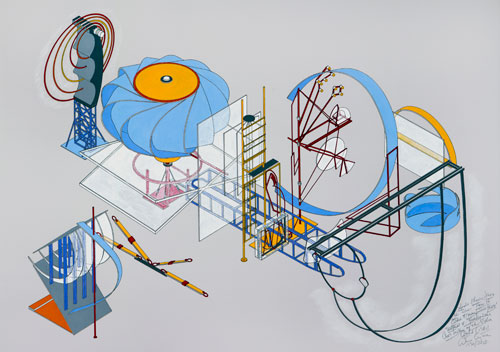
Alice Aycock. Hoodo (Laura) From the Series, “How to Catch and Manufacture Ghosts” – Vertical & Horizontal Cross-section of the Ether Wind (1981), 1990/2012. Watercolour and inkjet printing on paper, 27 ½ x 39 ¼ in. Collection of the artist.
JS: When you start a project, then, it might be a theory more than a visual idea that will jumpstart you. Something lying on a table or something you picked up at the bus station. Does this explain some of your titles – How to Catch and Manufacture Ghosts, On the Interaction of Particles of Thought, The Angels Continue Turning the Wheels of the Universe, or The Rotary Lightning Express. Can you talk about some of these ideas?
AA: I am a real dilettante. If the guys that work for me start talking about screws or "where do we put the bolts?", I totally blank out and walk away. Back in the 16th, 17th century, when the scientific/industrial revolution was just getting a head of steam, people discovered magnetism and electricity. They thought they could bring the dead back and create ghosts. Where does the Frankenstein myth come from? Now we do, in fact, bring people back from the dead with a jolt of electricity. There is a book in French about how to catch ghosts using electricity. I thought, I’m going to be making machines as art, but these machines are metaphors. They’re not going to make soup cans or cars, but they have to do something. So I made them “catch and manufacture ghosts”. I took images from inventions and experiments and put them back together the way magic systems work. It’s the methodology of surrealism – they negate cause and effect. The cause and effect is in your brain and your desire. We all want to bring the dead back and conjure up memories of times that are magnificently happy … to go back in time. So the work was really about dreams, memories, desires, fantasy and poetry.
JS: What about some of the ideas that obsessed you, and are still with you today? The labyrinth or winding vine, for example, still seems to be working at you. Way back, you were already investigating pathways. You still talk often about paths. I wonder what the path means for you.
AA: Well, I am interested in the idea of a journey. You make a plan and you think you know how it’s going to end, but you really don’t. It’s scary and exciting – an adventure. That’s what a path is. This notion could even go back to the garden path. It’s a kind of becoming in which events occur and they’re unpredictable and so for me, a path is a marvellous way to generate art.
JS: You seem to be attracted equally by the fragile and the for ever, the delicate flowers in your garden and the galvanic forces in the atmosphere. Do they ever connect for you?
AA: I’ve always made big pieces and used durable materials, yet many of them don’t exist anymore. I think it was Plato who said: “Ideas are not at rest.” An artist puts works of art out into the world, and hopefully they are picked up and carried into the future, but maybe just as a fragment. What gets carried forward is never really the actual thing. So I realised from the outset that everything is rather fragile. I may try to make works that last – all artists try to do that – but, in essence, it’s impossible. Most of the great things throughout human history were done by anonymous people.
JS: You’ve said that it’s just as OK to make something irresistibly beautiful or irresistibly dangerous. Is irresistible your bottom line?
AA: Yes!
JS: Do you want your work to be irresistible for the viewer or for yourself?
AA: Who else am I going to start with but myself? Generally, the work of the artists and writers I admire makes me say: “Oh, I wish I had thought of that – oh boy, is that true.” Or: “Oh! I don’t really want to think about that but it’s really true.” Louise Bourgeois always does that to me. So does Vito Acconci. To begin with I have to be brutally honest with myself. Most people would say they don’t want to think about something that’s irresistibly dangerous unless they’re watching a Superman movie. But of course that’s not true. It’s that approach/withdrawal syndrome: the more dangerous, the more seductive. I remember when my son was learning to walk. He would move towards me, then move away, towards and away. Children do that. That’s how they grow and develop. I think it’s a basic mammalian response. Some people say that I like to play on the wild side and it’s true. There is something about blades and propellers, how beautiful they are. You are almost hypnotised by them, but at the same time you have to keep your distance.
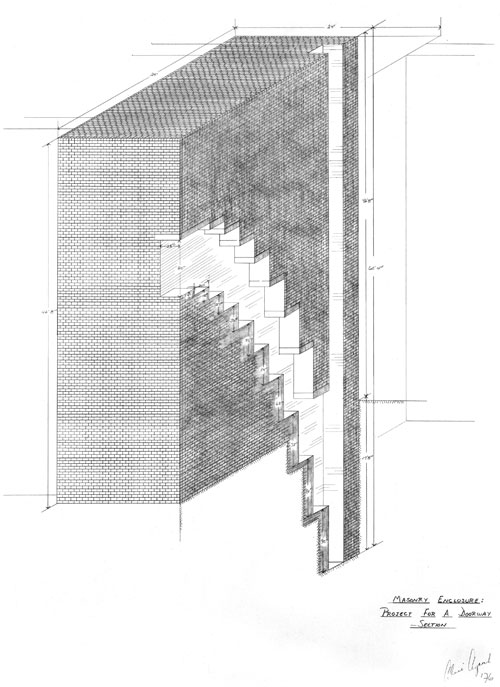
Alice Aycock. Masonry Enclosure: Project for a Doorway – Section, 1976. Graphite on tracing paper, 34 ¼ x 24 in. National Gallery, Washington, DC, Gift of Werner Kramarsky.
JS: Focusing in on the process, do you make detailed drawings and have direct contact with the metal? I know you work with a team.
AA: Originally, I would draw as an architect did, with rulers and graph paper and templates, planning things out to scale. If I was building in wood, I knew that wood came in 4x8 plywood sheets and 2x4s and 2x6s. I knew the standard sizes and drew according to how many pieces I needed. Now, with metal, I generally work with an assistant on the computer introducing images into a context using Photoshop and refining in Rhino, SolidWorks and AutoCAD. Gradually, through trial and error, a sculpture or installation will develop. With the pieces that I’m building for Park Avenue, I knew from the outset that there would be ribbons of aluminium.
JS: So you don’t need to make a model.
AA: We make models on the computer – renderings that look like the actual built work. The shop drawings we make on the computer tell the machine how to cut the metal precisely or how to build a sculpture on a 3D printer.
JS: So the computer has totally changed your process?
AA: Well, yes and no. I and my assistants could do it all by hand over a long time, and I’ve never made art without a plan. You don’t go down to the lumber yard and say “Give me 50 2x4s” and spend all that money and not know what you’re going to do. But what the computer lets me to do is make elaborate complicated forms that would have been very hard to plot out with pen and paper. Think of making a dress. It starts out as a flat pattern with curves. The computer does that in reverse. It builds a three-dimensional design and then structurally and conceptually analyses it. The computer allows my imagination to run wild at first, trying out many different ideas and to function on a high enough level to compete with a big architectural firm.
JS: Coming to your works on paper – recently the subject of such an extensive retrospective that it was split between the Parrish Museum in Water Mill and the Grey Art Gallery in Manhattan – since you are best known for large installations and outdoor sculpture, why this focus on the drawings? Is it because they had received less attention, because they are seminal to your investigations or because of their irresistible beauty?
AA: When I started out trying to plan the sculpture, I had to teach myself how to draw, because the teachers at the college I attended were Fluxus artists. They were not going to teach you how to draw; they were going to teach you to think, and to be provocative and have Happenings. I distrusted perspective. I was more interested in Cubist composition and collage, which was an asymmetrical fracturing of the picture plane and seemed to be a more contemporary way of analysing things. Cubism and Constructivism are still very interesting to me as compositional systems. So I would draw a plan, pull the lines up vertically, connect the lines across, and it was like magic – there it was, this three-dimensional thing. I knew I could not make everything I was drawing. I didn’t have the money or the site. So from the outset it became a combination of making things that I could build, making things that I would love to build but couldn’t, and making drawings as an imaginative work of fantasy. I had worked as a slide librarian so I was thinking about all of the different compositional systems throughout history. I started looking at Islamic art and medieval art and the flattening of the picture plane. Also, making drawings gives me enormous pleasure and I don’t have to worry about wind loads and money.
JS: The reviews have been spectacular. The only caveat I could find was that you are always rewriting the rules, which I would have thought the prerogative of an artist!
AA: Many of the drawings reference game boards. And the rules of the games are very contradictory. Minimalist art was the prevailing discourse when I entered the art game. Minimalism was very pragmatic. It was about construction and I really liked it. But it also closed out the world in all of its confusing and messy richness. Donald Judd said 1+1=2 and he did not want to know about anything else. That’s all there was. It’s blue, it’s this diameter and this size. That was fine for him, but in the world I know, I am constantly being assailed by images, contradictory truths and fictions and memories under construction. For me, the world is like that house that my father made. It has concrete dimensions and form, but the psychological lived experience of it in time is labyrinthine. I purposefully scramble the rules – maybe this logic that we keep trying to impose on our lives to keep control is impossible. Maybe you’ll never figure it out. Maybe he loved you, maybe he didn’t. Maybe he loved you for a while, but maybe he didn’t for ever. Maybe he lied, maybe he didn’t. Maybe every time you remember it, you make it up a different way. The world is always under construction and I am always reconstructing the world. So, yes, I am making up the rules as I go along. So is everybody else.
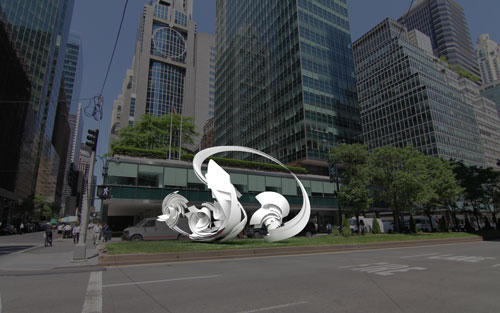
Alice Aycock. Hoop-La, 2013. Painted aluminum, 18’ high x 16’6” wide x 24’ long. Edition of 2. To be installed at 53rd street in Spring 2014. Courtesy Alice Aycock / PAPC & Galerie Thomas Schulte, Berlin. Rendering.
JS: Moving to the Park Avenue project, due in spring 2014. The advance buzz is exciting. Seven large installations on six blocks of Park Avenue heading north from 52nd street, entitled Park Avenue Paper Chase. What can you tell us about it?
AA: I have always been interested in wave movement and whirlpool movement. Like light waves and sound waves, the movement of water and wind are basic underlying visual systems that generate energy. The technological equivalent is the turbine. The whirlpool/whirlwind is a kind of order that is also about disorder. You’re creating something but you’re not quite sure what, as opposed to the grid system which is static and rigid and imposes a pre-existing organisational system of control. The Romans used the grid to subdue Europe, and the Americans used it to subdue the landscape from sea to shining sea. Although I have used it too, I wanted something else.
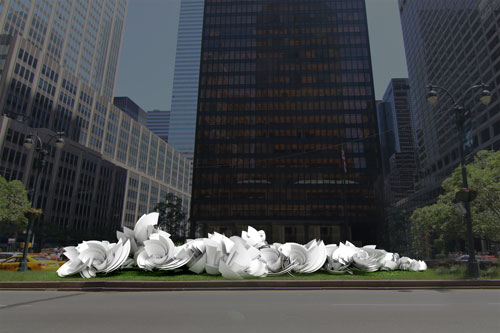
Alice Aycock. Maelstrom, 2013. Painted aluminum, approximately 12’ high x 15’6” w x 67’ long. Edition of 2. To be installed between 52nd and 53rd streets in Spring 2014. Courtesy Alice Aycock / PAPC & Galerie Thomas Schulte, Berlin.
For Park Avenue I was still thinking about random beautiful chaotic disorder and the complexity of chaotic systems. At the same time, the six major pieces – the seventh piece will be located further up the Avenue – have a kind of clarity that some of the earlier machine work does not. A tsunami for instance – when it first appears, you see the scattering of random things. It’s extraordinary but as it all piles up, it becomes junk. There is a thin line between vast piles of junk and an interesting scattering of things whose edges are malleable. I thought of Park Avenue as a succession of linked works that move up the avenue. I tried to visualise the movement of wind energy as it flows up and down the Avenue creating random spirals and whirlpools, touching down here and there and sometimes forming a dynamic three-dimensional massing of forms. One of the works references the expressive quality of wind through drapery and the chaotic beauty of fluid, or flow dynamics. I thought of the series of pieces as both celebratory like confetti and turbulent like a storm. It is the metaphorical visual residue of the energy of New York City. And that’s the way I think of New York – dangerous, provocative and exciting. That’s why people come here, that’s why we love it.
JS: The city is in high anticipation: we’re following it on your website. It’s such a big and important project that I hesitate to ask you what’s next. You always wanted to design a city. Is that still in the back of your mind?
AA: I’ve always wanted to design a city after Italo Calvino’s novel Invisible Cities, which is all about the city of Venice. In the novel, Marco Polo tells Kublai Khan about the cities in his empire. Each city has the name of a different woman. Halfway through, Marco Polo confesses that it’s really only Venice that he is describing. New York City is my Venice. It is the city that I may someday describe in drawing and every time I come back to it, it will be a different beautiful man.